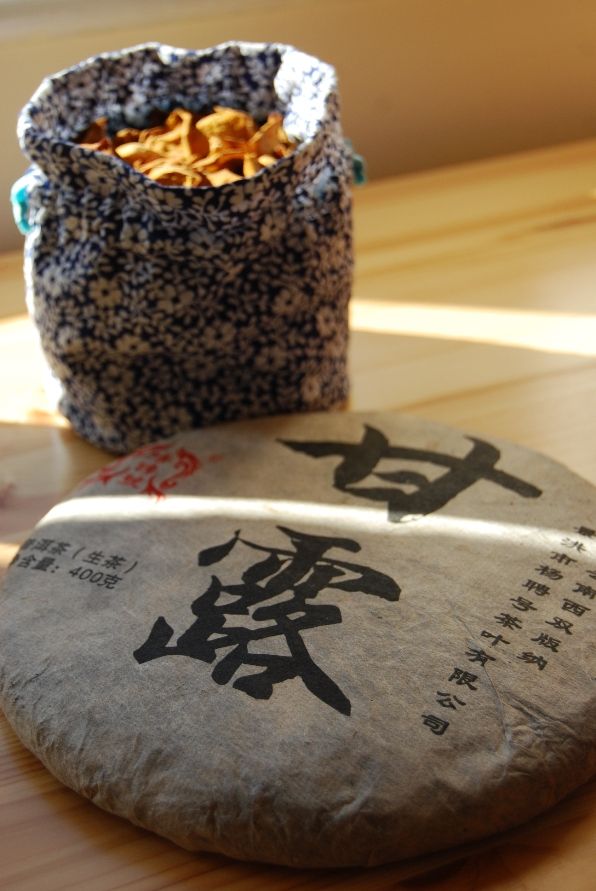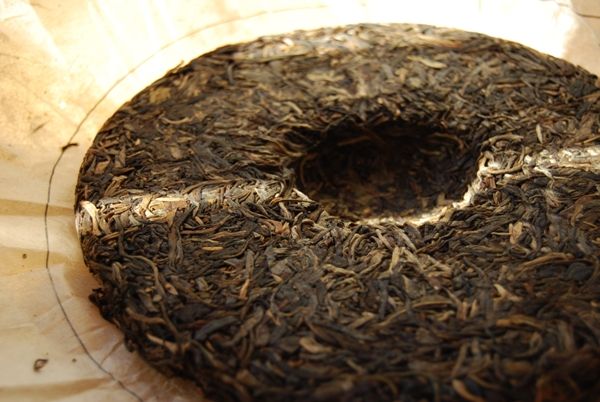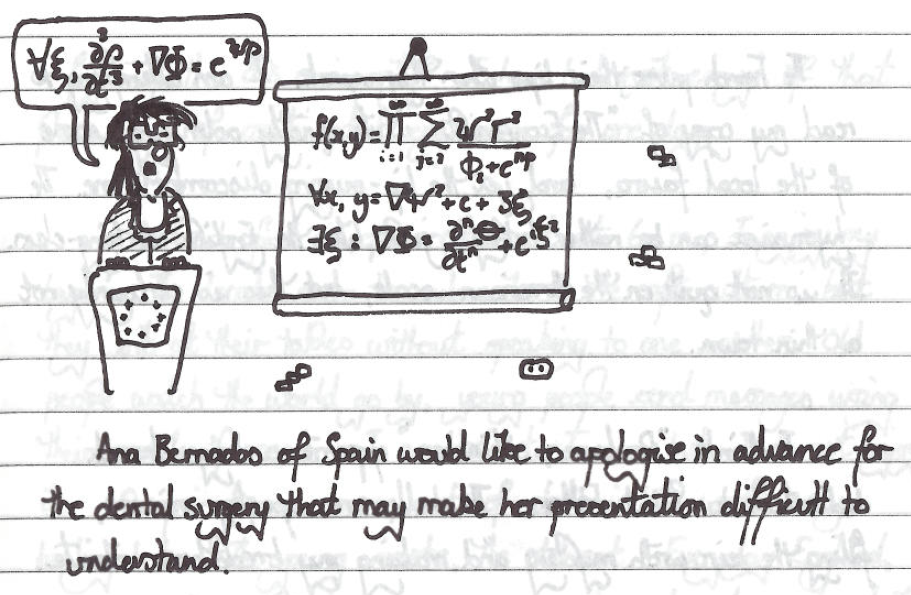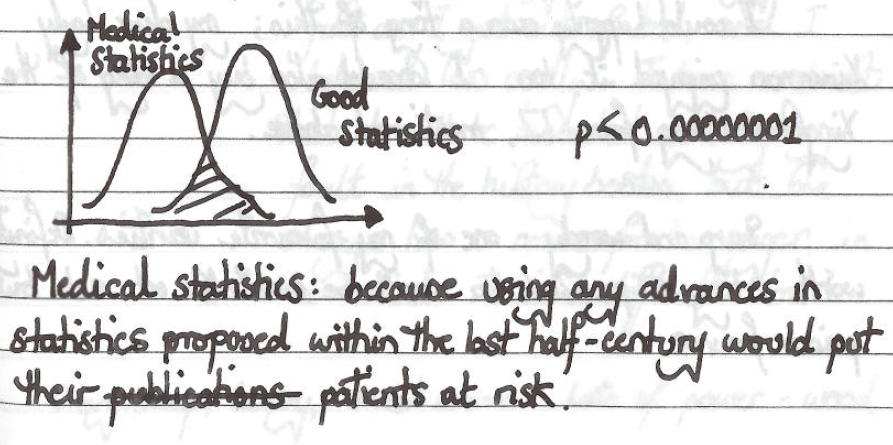When we previously tried the 2004 Yangpinhao, Mr. Yusko reminded me that my mother-in-law says I have too much tea. One occasionally sees photographs of houses laden down with pu'er, and I'm relieved to write that our humble abode is definitely not that bad. Yet.
However, "Chinese Mama", as she is known in our home, saw neither a triple-stack of large plastic storage containers filled with pu'er, nor the various boxes that have been arriving thanks to the generosity of Keng, and which we've bought from Taobao or Essence of Tea (many of the latter of which are still stored in my office, until our seemingly-Sisyphean house renovations have stabilised). In one of those hidden containers, this delightful Yangpinhao "Ganlu".
"Ganlu"
The cake's name is "sweet dew", which strikes a nice line between poesy and naffness.
It would take a heart of stone not to be wooed by the appearance of this tea: big, long leaves combine with a good, dusty shengpu aroma that brings hope to the spirit.
I estimate that this is a blend of raw and somewhat processed leaves - it has a leather darkness that cannot be achieved from nature alone, and yet it also has a sharp, bitter flavour (kuwei). The producers have done well, and this is not imbalanced in either direction, making it enjoyable yet slightly challenging.
It is a solid, reliable cake, with decent energy and a pleasant huigan. I wouldn't pursue any more of this, as I am strictly limited to buying only exceptional cakes, these days, given the size of our collection. While not exceptional, it makes for an enjoyable, low-maintenance session.
And speaking of low-maintenance, for those of you that follow my series of conference-based cartoons, I invite you to check your Facebook feeds...







5 comments:
Hello Half Dipper,
I love your site. Do you enjoy chais as well? If so, I'd like to suggest a chai tea for your review. It's called Tipu's Chai and it's an organic chai tea that's fair-trade and made from a recipe passed down through the owner's family directly from Gujarat, India.
Their instant chai is unsweetened and contains no milk products, so it's great for diabetics, the lactose intolerant and anyone else looking for a healthy cup of chai!
The Tipu's Chai sold in coffee shops across the Northwest even uses wind power to produce their tasty beverage, so its green, eco-friendly and sustainable - not to mention the best chai you'll ever have!
I'd love to back all this hype up with some samples of our chai, if you're interested. Just let me know where to send them. Thanks for your time.
p.s. sorry for the comment but I couldn't figure out how to contact you any other way. My mail is
travis dot clark at gttsmarketing dot com
Glad to see you are still at it. China shut down Blogger last June so I tried to start another tea blog using wordpress. Things went from bad to worse with a detached retina and everything that this means. Moved back to Bangkok this July and had one more operation on the eye.
I brought all my tea back and the accessories as well. As soon as I get the go ahead I will jump back into tea blogging. In the meantime, I will just keep up with my favorite blogs.
Dear Travis,
Thanks very much for the offer. I will have to respectfully decline your offer, though, as I'm not much of a chai drinker. I appreciate your generosity, however.
Dear Cecil,
I'm very sorry to hear about your difficulties; it sounds as if you're on the road to recovery now, however. We'll be keeping our collective eyes peeled for your blog.
Best wishes, and toodlepip,
Hobbes
I wonder how you store your teas (for ripening, I mean), given the not-so-conducive European climate? Seems to me like it's difficult to keep moisture AND Temperature right.
Above 20°C - we might get that a few weeks in summer, if we are lucky. Or, in a heated room temperature may be right, but moisture far too low ... How do you deal with that?
If I may leave another comment here, in the wrong place - I found your recommendation of a Weixiangbei really useful. Not only a good way to appreciate the aroma, but I found it also a good reminder what thinking outside the box can do ... I'm somewhat embarassed to admit that it never occured to me.
Best wishes,
Martin
Dear Martin,
I follow the age-old wisdom of placing the teas in an environment that humans would enjoy: not in the direct sun, out of strong breezes, but in a normal room with gently circulating air. They sit on shelves upstairs, in our house. The humidity in England is high, and in Oxford particularly so - we have two rivers, a canal, and a large nearby marshland! Of course, it rains a great deal, too (this is England, after all).
In terms of temperature, it seems OK. We're getting a lot of hot summers lately, and pu'er likes a good annual cycle. I believe in a policy of minimal intervention, which seems to be doing the trick!
I'm very glad to read that you found my piece about wenxiangbei / aroma cups helpful. I couldn't do without them! I understand that they are an acquired taste, but I simply cannot get the full range of information that a wenxiangbei provides just from sniffing the empty cup after drinking. The wenxiangbei gives a whole spectrum of changes in the aroma that I find quite useful when determining the potency of a tea.
Toodlepip,
Hobbes
Post a Comment